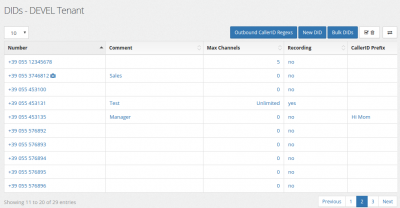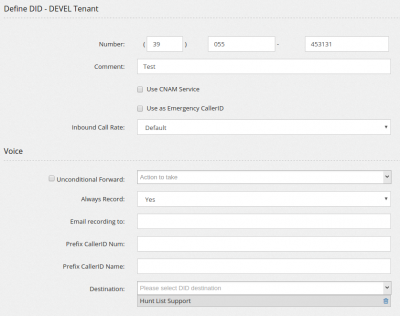DIDs
To every tenant can be assigned a group of DIDs, numbers to be dialed from the outside.
Each DID can be configured to reach a certain extension or Queue or Hunt Group or IVR or any combination of the elements defined for the tenant.
The same DID cannot be assigned to more than one tenant and there is no correlation between the dialing profile assigned to a tenant, the trunk provider used and the incoming DID.
For this reason is highly important that the incoming INVITE from the trunk provider contains all the info to identify correctly the DID it is addressing to.
Due to the fact there is a lack of strong standardization among trunk providers on how to transmit the DID information, a “best guess” is used to identify the correct DID, using any of the format currently in use around the world.
A DID can be configured to accept voice, fax or try to guess the calling party (if voice of fax).
Autodetection relies on signalling at the start of the call and cannot be always reliable.
The time to detect the fax tone can be set in Admin/Settings page.
Editing New/Define DIDs
The number must be entered in three parts, starting with international prefix, area code and number. Even if your telephone standard doesn't allow the usage of any “short” form for dialing the number, requesting for example, to dial always the area code, the number is requested to be entered this way. Using the Admin/Settings menu is possible to enable the use of a “single box DID” to just enter the number in a single box, but this is highly discouraged.
It is possible to use regular expression inside the number. In case multiple regular expressions match the number dialed, the ordering is based alphabetically on the Comment.
Comment is just a comment and it is not used in any way.
Max channels allows you to set the maximal number of channels available on the DID. Any additional call received will be refused with a busy signal.
Use CNAM service allows you to assign the Caller ID Name based on this popular service offered in most countries. You can configure the service in Admin/Settings page.
Use as Emergency CallerID permits you to mark this DID as one of the available to be used when an emergency call is dialed. Due to the fact the emergency numbers are not standard among all countries, it is your duty to assign the “emergency flag” to the dialing rules for emergency numbers. When a call is dialed and it is using a dialing rule marked as “emergency”, the Caller ID number used for the extension is the one defined as “Emergency” among the ones with this flag set.
Inbound Call Rate allows you to define a call rate for inbound calls.

